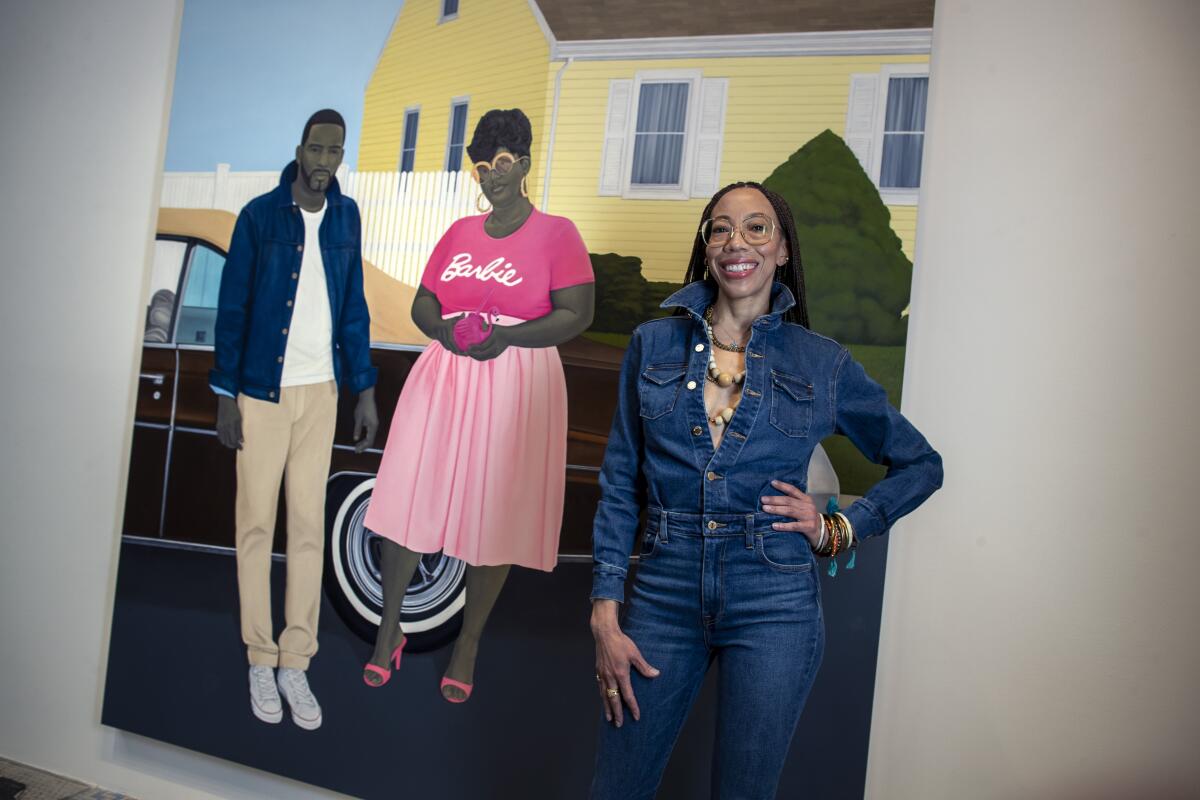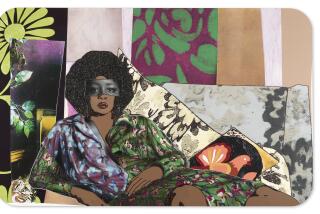How Amy Sherald’s paintings capture the spectacularly mundane moments of Black life

Amy Sherald began experimenting with her signature style — painting Black people in gray monochrome — around 2008. At the time, she was working in her Baltimore studio and painting people true to their complexion when another artist suggested she paint figures using grayscale to speed up the artistic process.
It became an aesthetic choice that eventually clicked. Since her 2012 work “Equilibrium,” Sherald has painted only Black people, often set against vibrant backgrounds or wearing colorful outfits. But the people themselves — including her most famous portrait subject, former First Lady Michelle Obama — are gray.
Over time, Sherald, 48, realized that the choice to interpret the rich complexity of Black skin in gray tones could be a response to the marginalization of Black art — “the conversation and discourse around and just solely being about identity,” she said. “I wanted it to exist in a world in a more universal way.”
“I’m not trying to take race out of the work,” Sherald added. “I was just trying to figure out a way to not make it the most salient thing about it.”
Sherald, who now lives in the New York area, recently unveiled paintings in her first West Coast solo show, which is on view through June 6 at Hauser & Wirth Los Angeles. “The Great American Fact” features five paintings made in 2020 centering Black ordinary life. One painting, about 11 feet by 9 feet, depicts two Black surfers at the beach in wetsuits.
Sherald’s portraits often depict people she encounters in public. She notices a spark, something “that is really probably only seen and felt by me, people that just kind of have a weight to their energy and spirit,” Sherald said. “There’s usually something a little awkward and quirky about them that really starts to get my mind thinking that I want to pursue them and make them into a painting.”
Sherald began two works before the pandemic. She found the model in her 54 inch-by-43 inch painting “Hope is the thing with feathers (The little bird)” onstage at an Alvin Ailey American Dance Theater performance.
When nationwide closures and quarantines forced people inside last year, Sherald turned to Instagram, scouring hashtags and using six degrees of separation to find new inspiration. Social media is how she found the woman in her painting “A Midsummer Afternoon Dream,” who seems at ease posing against a yellow bicycle in a billowy blue dress.
“My work doesn’t commit Black life to grief,” Sherald said. “There’s an assumption of a whole Black life being inextricably tied to struggle. I think it becomes all-consuming and really can codify our existence and our whole experience.”
Instead of painting what she describes as the exclamation points and periods — “when there’s loss of life, it’s a period at the end of a sentence,” she explained — Sherald sees her work representing the “dash” of life, the in-between moments of everyday living. “I feel like I’m returning us to our rightful place, which is in all of our natural elements like a fully functional person.”
Born in Columbus, Ga., Sherald received her bachelor’s degree in painting at Clark Atlanta University and master’s degree from Maryland Institute College of Art. After receiving first prize in the 2016 Outwin Boochever Portrait Competition, the Smithsonian’s National Portrait Gallery commissioned Sherald to make the official portrait of the former first lady, which was unveiled in 2018.
Video killed the radio star, but, save for a few exceptions, photography killed presidential portrait painters.
Her second commission came last summer from journalist Ta-Nehisi Coates, who asked her to create a portrait of Breonna Taylor, the 26-year-old Black woman killed by police inside her Louisville apartment, for the cover of Vanity Fair. Sherald spent time talking to Taylor’s mother, Tamika Palmer, to get a deeper understanding of her daughter’s personality, creating a painting that rendered Taylor graceful and regal.
Sherald’s painting of Taylor will be jointly owned by the Smithsonian’s National Museum of African American History and Culture in Washington, D.C., and by the Speed Museum in Louisville. “I needed to find an institution that would be a good steward of this work and to place her life in this painting into a context where it could continue to tell a story,” Sherald said.
Museum spaces are important, for some an introduction to the Black experience. “A lot of people really have no perception of who we are and how we live,” Sherald said. “We live very boring lives, just like everybody else.”
She referred to the group of Black middle school students who said they experienced racism from staff and patrons at the Museum of Fine Arts, Boston, in 2019.
“They were stared at and made to [feel] as if they didn’t belong there,” Sherald said. “I think about work like mine being in spaces like that, and the kind of introduction that that would have made — not only to the white viewers that were in the gallery, but the sense of ownership that those Black children would have had.”
She was recently tagged in an Instagram post that brought her to tears.
Someone snapped a picture of her painting “As American as apple pie,” zooming in on the detail in the man’s hair, writing: “I’ve never in my entire artgoing life, from adolescence to now, seen the brush waves of my youth immortalised on canvas with such care, nuance, love, + unique understanding.”
Sherald feels nostalgic thinking about how her father wore his hair in this way, creating sleek waves with pomade and meticulous brushing.
“The beauty of that one simple, everyday, boring little banal action is something that’s a part of our culture,” Sherald said. “And a part of our cultural history.”
Amy Sherald, ‘The Great American Fact’
Where: Hauser & Wirth Los Angeles, 901 E.3rd St.
When: 11 a.m.- 6 p.m. Tuesday-Sunday, through June 6. Timed viewing appointment required on weekdays; stand-by line on weekends.
Admission: Free
Info: www.hauserwirth.com
More to Read
The biggest entertainment stories
Get our big stories about Hollywood, film, television, music, arts, culture and more right in your inbox as soon as they publish.
You may occasionally receive promotional content from the Los Angeles Times.











